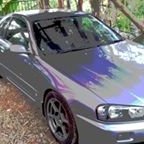Announcements
-
Similar Content
-
Latest Posts
-
You've done it wrong. I don't have time right now to type up enough. I'll have to come back to it or maybe someone else will in the meantime. The boost signal has to pass through the MAC valve from boost source (turbo outlet - effectively anywhere between the turbo outlet and the throttle body will do, but closer to the turbo outlet is best) to the wastegate. What you have done is connected it sort of like the stock solenoid. But it doesn't work the same way as the stock solenoid. That Tee piece that you have connected the solenoid to....? The solenoid itself serves that function. You should look up a typical MAC valve connection diagram for a single turbo internal wastegate application. You'll find one easily enough. Every single boost controller manufacturer that uses MAC valves will have one. Bugger it, I'll just grab the HP Academy one. The other thing you have to get right is that the boost source has to be connected to the correct port on the solenoid valve. This is because the solenoid makes the valve switch from connecting 2 of the ports when it is unpowered, to connecting one of those first 2 ports to the third port when it is powered. One inlet, two outlets. You will note from the diagram that the common port is port 3, the port to the wastegate is port 2, and port 1 is the vent (where the boost signal escapes when the solenoid pulses ON). As to the BOV.... the vacuum signal for the BOV simply has to come from the plenum. It must register boost when you're on boost and vacuum when the throttle is closed. That's all. The original location on the plenum is best. Best practice is never to interfere with the vacuum line running to the FPR. Just leave that one alone, as you will avoid causing unintended problems that might occur if you mess something up.
-
I was able to complete installation of the G4X ecu. I needed to reroute MAP vacuum signal from stock location to where BOV is connected on the intake plenum. Has anyone needed to do the same? When I connect vac port by the BOV flange to my HKS BOV, it doesnt work and I get flutter. I would to get BOV working, where would it be best to T in? Or would it best for me to move MAP vac line and T into FPR? Secondly, I installed a MAC 3 port boost solenoid and wanted to know if i routed it correctly. I place two lines from stock boost solenoid and placed it on ports 1 and 2, leaving 3 vented. The T for wastegate and boost source on compressor elbow is on port 2, and port 1 is connected to turbo inlet intake pipe. Please see attached pictures. Ill upload ecu config later today. Thanks in advance.
-
some people are still around weirdly enough - most people just use facebook now to ask the same 12 questions tho XD
-
Omg Rezz! Yep we're still here and actually seeing a trickle of oldies coming back. How's things?
-
By GoHashiriya · Posted
So I raised the car up a fair bit for shipping - see image - then lowered it again when it arrived. I then rushed to get an alignment in NL before the track and the shop just wasn’t anywhere near as precise as what I got in Japan. The guys that did the alignment this week said there was a fair amount of toe in the rear that could have contributed to the understeer. It was also the case that the rear camber went from about -2 to -3 at the shop in NL. However, since I’ve now got slightly wider tires in the rear - NS2Rs run wider than Accelera 651S - I could only get a minimum of -3 in the rear now due to clearance. Front is now -2.75 (-2.45 in minutes) due to being raised a bit (previously -3 in JP). So it’s likely a combination of the two factors, camber and toe. The issue now is I have more camber in the rear than the front and the next step on the front Cusco arms will put me at -3.5ish front which seems a bit excessive to me. The weird thing is I’ve never had any understeer at the track in Japan but they are very different circuits - Japanese circuits are much slower than the one I’ve been to here. I’m probably going to have to start another thread for the E90. The plan is sort of to keep it as a daily but progressively mod it into a track car - honestly, you need a cage for the sort of speeds you go here. Just ordered the M3 front arms btw. Love the car despite it being in pretty shitty condition. Oil analysis came back okay and it seems to have stopped consuming oil since fixing a load of engine bay things. Saw yours is a 335i right? f**king mistake on my part getting the DI N53 over the N52, fuel economy is insanely good though at 14-16 km/L. Cheers, it’s great to see the benefits and pitfalls of different places. I’m contemplating going back to the U.K. around next year as the cost of living in the Netherlands is just ridiculous. GF is nagging me to settle and buy a house but I don’t know what LSD to buy.
-







Recommended Posts
Create an account or sign in to comment
You need to be a member in order to leave a comment
Create an account
Sign up for a new account in our community. It's easy!
Register a new accountSign in
Already have an account? Sign in here.
Sign In Now